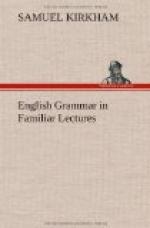Those specifying adjectives commonly called Adjective Pronouns, may be divided into three sorts; the distributive, the demonstrative, and the indefinite. They are all known by the lists.
I. The distributive adjectives are those that denote the persons or things that make up a number, each taken separately and singly. List: each, every, either, and sometimes neither; as, “Each of his brothers is in a favorable situation;” “Every man must account for himself;” “Neither of them is industrious.”
These distributives are words which are introduced into language in its refined state, in order to express the nicest shades and colors of thought. “Man must account for himself;” “Mankind must account for themselves;” “All men must account for themselves;” “All men, women, and children, must account for themselves;” “Every man must account for himself.” Each of these assertions conveys the same fact or truth. But the last, instead of presenting the whole human family for the mind to contemplate in a mass, by the peculiar force of every, distributes them, and presents each separately and singly; and whatever is affirmed of one individual, the mind instantaneously transfers to the whole human race.
Each relates to two or more persons or things, and signifies either of the two, or every one of any number taken separately.
Every relates to several persons or things, and signifies each one of them all taken separately.
Either relates to two persons or things taken separately, and signifies the one or the other. “Either of the three,” is an improper expression. It should be, “any of the three.”
Neither imports not either; that is, not one nor the other; as, “Neither of my friends was there.” When an allusion is made to more than two, none should be used instead of neither; as, “None of my friends was there.”
* * * * *
II. The demonstrative are those which precisely point out the subject to which they relate. List: this and that, and their plurals, these and those, and former and latter; as, “This is true charity; “that is only its image.”
There is but a slight shade of difference in the meaning and application of the and that. When reference is made to a particular book, we say, “Take the book;” but when we wish to be very pointed and precise, we say, “Take that book;” or, if it be near by, “Take this book.” You perceive, then, that these demonstratives have all the force of the definite article, and a little more.
This and these refer to the nearest persons or things, that and those to the most distant; as, “These goods are superior to those.” This and these indicate the latter, or last mentioned; that and those, the former, or first mentioned; as, “Both wealth and poverty are temptations; that tends to excite pride, this, discontent.”




